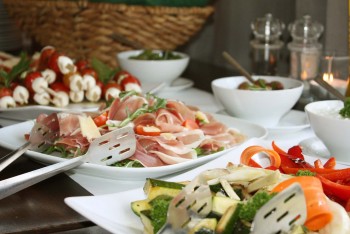Funeral Dinner Menu Planning
Although you are not required to feed all the funeral guests as soon as the service is over, partaking of a funeral dinner (or luncheon) is a common part of the mourning ritual. Some families choose to have this event catered, some hold it in a favorite restaurant or bar, some ask for guests to bring dishes to eat potluck style, and still others do the cooking themselves.
While there is no right or wrong way to hold a funeral dinner, it is common to serve comfort foods and favorite dishes of the deceased. If you are planning a funeral dinner menu, here are a few staples you won’t want to miss.
- Casseroles: Casseroles are popular among funeral crowds for several reasons. For one, they can be prepared ahead of time, making serving the meal as easy as heating the dish and setting it out. For another, they tend to be heavy on things like cheese and carbohydrates—comfort foods that appeal to a broad range of people. (If you will be asking people to supply dishes for a potluck, these have the added advantage of freezing well or being eaten as leftovers.)
- Sandwich Platters: Sandwich platters typically include bread, meat, cheese, and other fixings for sandwiches. Easy to make (or purchase), they offer guests a chance to create their own meals, and tend to work best when the funeral dinner is meant to be more relaxed and casual.
- Buffet-Style Meats: If you will be serving funeral guests a hot meal, buffet-style meats (ham, turkey, or roast that is carved) work best. You can also opt for meatballs, fried chicken, or pulled pork, which can be portioned to suit each individual guest’s appetite. Barbeques tend to work best when the funeral takes place in good weather or the after-service is held outdoors.
- Salads: If you want to serve salad at a funeral luncheon or dinner, avoid ones that will spoil easily or that have dressing directly on the greens (as they tend to wilt quicker). Pasta salad, bean salad, gelatin salad, and build-your-own salads work best in this type of situation—especially if the leftovers can be stored and served later.
- Finger Foods: If you are not feeling up to the task of heavy cleanup after the funeral dinner, stick to finger foods that minimize the need for serving dishes, cutlery, and plates. Vegetable trays, chips and dip, hummus and pita bread, kabobs, miniature sandwiches, and other items you can eat with your hands will minimize the amount of work you have to do once everybody leaves.
- Desserts: Nothing says comfort food quite like dessert. Funerals are not the right occasion for an elaborate cake or festive cookies, but it is always a good idea to add something sweet to the menu. Cookies and cupcakes, dishes of candy, dessert bars, and other treats tend to work well in funeral settings. These go over well when served with coffee.
As with most tasks related to funeral planning, it is best not to stress too much about the funeral dinner. Although it is nice to want to provide a meal for family and friends, it is more about being together than providing five-star dishes and table service. Stick to simple, comforting foods and put the focus on celebrating the life of the deceased. The funeral dinner will be all the better for it.
Please share your thoughts on this article
Related articles
Alternative Ways to Pay for a Funeral
Most people do not have the $5,000 to $15,000 necessary to pay for a funeral outright. This kind of money, usually needed at the last minute and often in addition to high medical bills, is a serious burden on anyone who does not have a large savi... more »
Can I Hold a Funeral at Night?
Funeral planning and traditions have become such an ingrained part of our culture that any sort of deviance from routine is automatically questioned. Most funerals are held on weekdays during the day. Families and friends share prayers and eulogi... more »
Save Money with a Green Funeral
If you’re a fan of recycling, turning down the thermostat, and otherwise doing your part for the environment, then you may have already considered a green funeral in your funeral planning process. If you simply like to save money, however, you migh... more »



